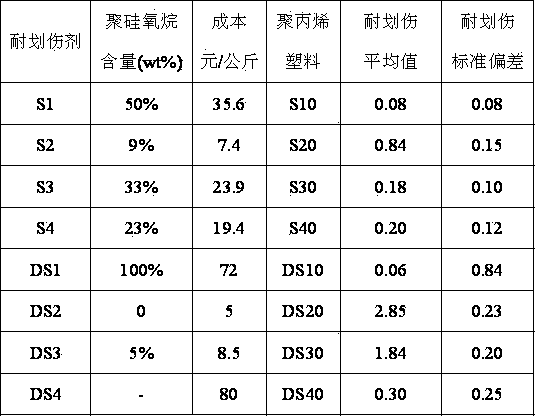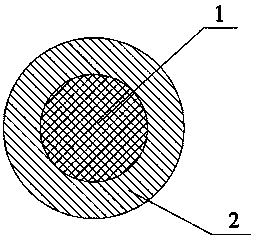Scratch resisting agent and preparation method thereof as well as polypropylene plastic
A scratch-resistant agent and solvent technology, applied in the field of plastic modification, can solve the problems of inconsistent migration speed of scratch-resistant agent, easy scraping of filler, high cost, etc., achieve high balance of scratch-resistant effect and improve scratch-resistant Damage effect, easily controllable effect
- Summary
- Abstract
- Description
- Claims
- Application Information
AI Technical Summary
Problems solved by technology
Method used
Image
Examples
preparation example Construction
[0022] The present invention also provides the preparation method of described anti-scratch agent, comprises the following steps:
[0023] A. Disperse the inorganic filler in the solvent to form a filler dispersion;
[0024] B. Add base rubber to the filler dispersion, then add catalyst and crosslinking agent, form polysiloxane on the surface of the inorganic filler by in-situ polymerization, and pulverize after drying to obtain the scratch-resistant agent; the base gum is active A group-terminated organosiloxane polymer, the cross-linking agent is an organosilicon capable of cross-linking reaction with the gum base.
[0025] Specifically, in the present invention, the inorganic filler is first dispersed in a solvent to form a filler dispersion, so that the subsequent base glue, cross-linking agent and filler are uniformly dispersed, which facilitates the coating of the surface of the inorganic filler with polysiloxane. In this step A, the solvent is an alcohol or an aqueous ...
Embodiment 1
[0043] (1) Disperse 100g of inorganic filler calcium carbonate with a particle size of 1000 mesh in 1000g of solvent ethanol to form a filler dispersion. Add 100g base vinyl liquid silicone rubber to the filler dispersion, stir evenly, then slowly add 10g catalyst chloroplatinic acid and 40g crosslinking agent hydrogen-containing silicone oil with a dropping funnel, and react for 24 hours under stirring. The reaction product was separated from solid to liquid, the filter cake was washed, dried at 50°C, and pulverized to obtain the scratch-resistant agent S1 of this example, which has figure 1 structure shown.
[0044] (2) Weigh 50g of anti-scratch agent S1, 700g of polypropylene, 40g of polyethylene olefin elastomer, 200g of modified talcum powder with a particle size of 1250 mesh, 2g of ethylene bis stearic acid amide, 2g of antioxidant lrganox1010, 2g Antioxidant lrganox168, 1g calcium stearate, 1g light stabilizer and 2g aluminate coupling agent, use a high-speed mixer to ...
Embodiment 2
[0046] (1) Disperse 100g of inorganic filler talc powder with a particle size of 6000 mesh into 10000g of solvent isopropanol to form a filler dispersion. Add 10g of gum-terminated hydroxyl polyorganosiloxane to the filler dispersion, stir well, then slowly add 0.005g of catalyst 1,3-divinyl-1,1,3,3-tetramethyldi Siloxane platinum and 0.5 g crosslinking agent triethoxysilane were reacted for 1 h under stirring. The reaction product was separated from solid to liquid, the filter cake was washed, dried at 120°C, and crushed to obtain the scratch-resistant agent S2 of this example, which has figure 1 structure shown.
[0047] (2) The polypropylene plastic product S20 of this example was prepared by the same steps as in step (2) of Example 1, except that the scratch-resistant agent S2 was used instead of the scratch-resistant agent S1 in Example 1.
PUM
| Property | Measurement | Unit |
|---|---|---|
| particle size (mesh) | aaaaa | aaaaa |
Abstract
Description
Claims
Application Information
 Login to View More
Login to View More - R&D
- Intellectual Property
- Life Sciences
- Materials
- Tech Scout
- Unparalleled Data Quality
- Higher Quality Content
- 60% Fewer Hallucinations
Browse by: Latest US Patents, China's latest patents, Technical Efficacy Thesaurus, Application Domain, Technology Topic, Popular Technical Reports.
© 2025 PatSnap. All rights reserved.Legal|Privacy policy|Modern Slavery Act Transparency Statement|Sitemap|About US| Contact US: help@patsnap.com


